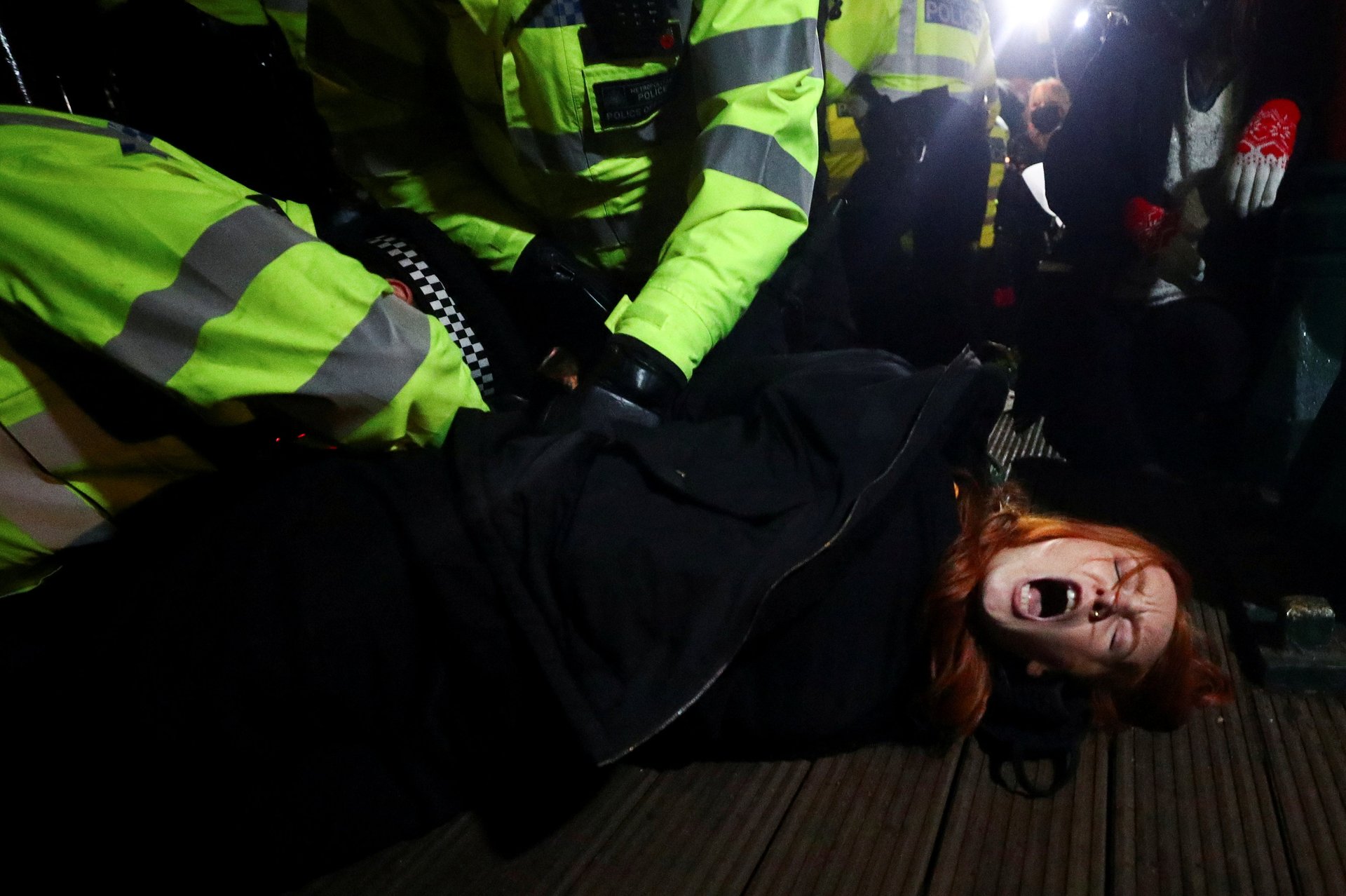Scenes in London capture global protests against gender-based violence
One photograph quickly became iconic: a woman in a black mask, Patsy Stevenson, held down by two male police officers on the floor of the Victorian bandstand on London’s Clapham Common.


One photograph quickly became iconic: a woman in a black mask, Patsy Stevenson, held down by two male police officers on the floor of the Victorian bandstand on London’s Clapham Common.
Stevenson was one of hundreds of people who had gathered Saturday evening (Mar. 13) in a vigil for Sarah Everard, after serving Metropolitan Police officer Wayne Couzens, 48, was charged on Friday with her kidnapping and murder. The vigil turned into an anti-violence protest, and ended with a show of force, captured on video, by the police that leaders across the political spectrum condemned as “upsetting,” “unacceptable,” and “deeply disturbing.”
UK prime minister Boris said he is “deeply concerned” by the footage, and is chairing a meeting of the government’s crime and justice taskforce today (Mar. 15) to discuss better protection for women.
London’s police force is under the microscope
London’s assistant police commissioner Helen Ball defended the officers’ actions as necessary to enforce lockdown restrictions: “We repeatedly encouraged those who were there to comply with the law and leave. Regrettably, a small minority of people began chanting at officers, pushing and throwing items.”
On Sunday, mayor of London Sadiq Khan and home secretary Priti Patel called for independent investigations into officers’ actions at the vigil, and Conservative MP Damian Collins accused the police of “using the language of the abuser to its victims over the years—it’s your fault, you made us do it.” Metropolitan police commissioner Cressida Dick, the first woman in the role, declined to resign. And protesters continued to gather.
The ubiquity of gender-based violence
The frightening circumstances around the death of Everard, who was 33, and disappeared as she walked home at night in south London, are rare in Britain.
But in a new UN Women UK survey, 97% of women between 18 and 24 reported being sexually harassed, and 80% of women of all ages said they had been sexually harassed in public spaces. 96% had not reported the incidents. Domestic violence and killings of women by their partners have risen in Britain during the lockdowns of the past year.
In the days leading up to the weekend’s protests, women across the UK had been sharing their experiences of street harassment and domestic violence on social media. In the Guardian, columnist Marina Hyde wrote about being followed and harassed on the street just the day before while picking up her son at school.
A global movement
On International Women’s Day last week (Mar. 8), women clashed with police in Mexico City during a huge demonstration against the government’s perceived inaction on gender-based violence there, while there were also large marches in Australia this weekend, sparked by allegations against prominent politicians of sexual assault.
The momentum feels familiar, like the swell of shared stories of sexual assault and harassment in the wake of Donald Trump’s Access Hollywood tape in 2016, after the New York Times published decades of allegations against Harvey Weinstein in 2017, and during US Supreme Court justice Brett Kavanaugh’s confirmation hearings in 2018. And now, New York governor Andrew Cuomo is under investigation after multiple women, including several former aides, accused him of sexual harassment.
Some of those stories led to a reckoning in the business world, with Weinstein in jail and a number of male executives losing their jobs. But Trump won the 2016 election, and Kavanaugh won his seat on the court.
In 2020, after a police officer killed George Floyd in Minneapolis, people turned out to protest in 60 countries around the world. In London, the protests began three days after his murder, on the same day as in New York City, and they continued around the UK nearly every day for more than three weeks.
A movement can spread quickly, but it’s too soon to tell how much difference this round of storytelling and protest by women will make. It depends in part on whether business leaders as well as government officials begin to recognize the real costs of gender-based harassment and violence on the streets, inside homes, and in workplaces.